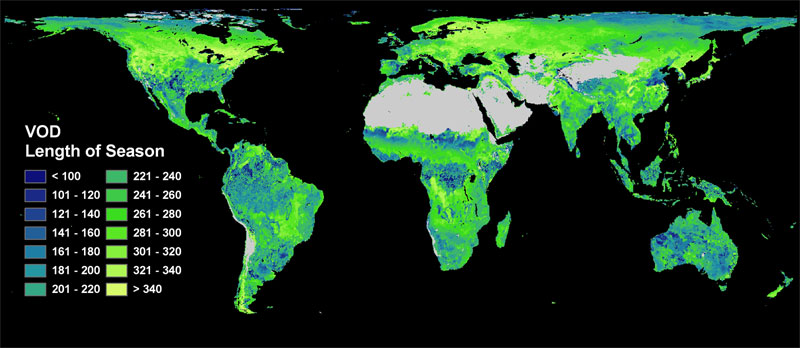Phenology Assessment Using Satellite Radar & Microwave Remote Sensing
Project Summary
Vegetation Phenology Assessment Using Satellite Radar Remote Sensing: Global Monitoring of Daily and Seasonal Changes in Canopy Structure and Water Status.
Seasonal vegetation dynamics significantly impact the carbon cycle and weather (surface energy balance, transpiration vapor fluxes). These impacts are related to growing season length for evergreen ecosystems, to timing of leaf flush and senescence for drought- or cold-deciduous systems, and to seasonal and annual variability in canopy biomass. Spaceborne remote sensing is the only practical tool for monitoring seasonal vegetation dynamics globally with high temporal repeat and moderate spatial resolution.
We are working to establish a satellite radar and microwave remote sensing-based methodology and associated product time series for global assessment and monitoring of vegetation phenology, capitalizing on the systematic, multi-year (1999 onward) measurement series provided by the SeaWinds scatterometers and AMSR-E radiometer. We exploit the high temporal repeat, all-weather capabilities of satellite radar and microwave and dynamic radar backscatter sensitivity to both vegetation structure and water status to develop a comprehensive phenology measure that is synergistic with existing satellite optical-IR based approaches that are primarily sensitive to effective (sunlit) leaf area and photosynthetic biomass.

Image is estimated Length of the Growing Season derived from the AMSR-E Vegetation Optical Depth (VOD) Land Surface Parameter. VOD is part of a suite of land surface parameters calculated at NTSG/FLBS and is available via our ftp site.
NTSG Personnel
- John Kimball
- Lucas Jones
- Matt Jones
Funding Agency:
Selected Publications
Du, J., J.S. Kimball, L.A. Jones, Y. Kim, J. Glassy, and J.D. Watts, 2017. A global satellite environmental data record derived from AMSR-E and AMSR2 microwave earth observations. Earth System Science Data Discussions, doi:10.5194/essd-2017-27.
Jones, M.O., J.S. Kimball, E.E. Small, and K.M. Larson, 2014. Comparing land surface phenology derived from satellite and GPS network microwave remote sensing. International Journal of Biometeorology, 58:1305-1315.
Jones, M.O., J.S. Kimball, and R.R. Nemani, 2014. Asynchronous Amazon forest canopy phenology indicates adaptation to both water and light availability. Environmental Research Letters 9, 124021.
Jones, M.O., L.A. Jones and J.S. Kimball, 2013. Satellite microwave detection of boreal vegetation recovery from the extreme 2004 wildfires in Alaska and Canada. Global Change Biology 19, 3111-3122.
Jones, M.O., J.S. Kimball, K.C. McDonald, and L.A. Jones, 2011. Utilizing satellite passive microwave remote sensing for monitoring global land surface phenology. Remote Sensing of Environment 115, 1102-1114.
Jones, M.O., J.S. Kimball, L.A. Jones, and K.C. McDonald, 2012. Satellite passive microwave detection of North America start of season phenology. Remote Sensing of Environment, 123, 324-333.
Li, Y., K. Guan, P. Gentine, et al., 2017. Estimating global ecosystem iso/anisohydry using active and passive microwave satellite data. JGR-Biogeosciences, DOI:10.1002/2017JG003958.
